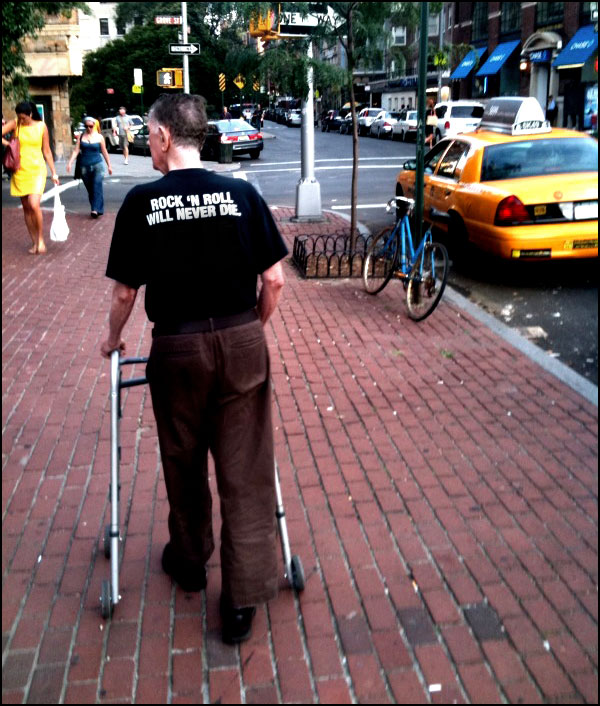
Now, this is sending a message.

I’m becoming kind of fixatated on hair. It started with my students, and mostly the guys. There’s a trend towards funk. I don’t mean P. Funk style, though one can certainly see there some roots (puns are cool, you know it) in George Clinton’s glorious mane. 
Okay, I’m not saying that this look is hot right now — but certain variations on the theme are. This makes me feel old to say, but college students do keep one somewhat attuned to the hip/ster look of the moment. And these days, I see a lot more variety in guys’ hair — one student has a Two-Face thing going on, another has a wild layered shag that requires constant handling; the faux hawk is still around, and frosted tips are coming back. And these aren’t even emo kids I’m talking about.
That’s what I find most interesting–the diversity of it all, and the way that no style seems clearly identifiable with any particular ideology. I dig it, in the same way I like watching this generation of college men, or at least some, being far more, well, liberated in their performance of gender.
Today’s NYT contains an article by David Colman about this very issue, noting both the historical use of hair as identification and the present play with those very notions:
Once upon a time — say, 40 years ago this week, when long-hairs thronged to Woodstock by the hundreds of thousands — you got a hairstyle to show the world your affiliation, to brandish a cultural identity defined by your musical tastes, your political views or how depressed you were. But such literal interpretations of hair appear to be utterly passé, even if the hairstyles themselves are not.
And check out this slideshow.
This really brings up the central rhetorical question of intention and reception — which one “counts” in terms of a text’s “meaning”? If I were to interpret my students’ ‘dos as representative of beliefs or values, I might be way off base. But then again, it’s quite likely I wouldn’t be the only audience with such an interpretation, and that such readings would influence, well, “reality.” So what would the hair mean? As Colman concludes, “To turn an old ad slogan on its head: Not even his hairdresser knows for sure.”
Have you heard of Jezebel? I look at this publication kinda as a sarcastic Vanity Fair. Although they talk about celebrity, fashion, and stereotypically girlie things, they’re quite critical of it all. For instance, they have articles ranging from the ever-evolving drama of Jon & Kate Plus 8 to animal rights advertising to an excellent run-down and critique of Huckabee on The Daily Show. The site’s description:
Jezebel is celebrity, fashion, and sex without the airbrushing. The witty, informative tone draws a readership that is intelligent and sophisticated, but still willing to get down and dirty. Jezebel does what those women’s monthlies only wish they could.
Sorta reminds me of Harlot–exchange all of that celebrity and fashion stuff for rhetoric and we ain’t far off. Certainly, I think some of their articles fit nicely into the realm of rhetorical critiques of pop culture with a dash of wit. Given the site’s high readership, perhaps there’s something that Harlot could learn from its (maybe not-so) distant cousin. Of course, they’ve been at it a bit longer, have major sponsors, and their editors even get paid! Ah, to earn a wage at this. Harlot is a bit too indie for that major sponsorship though, eh? And we encourage our audience to be more participatory as well. It’s a thought. One still in development.
I find myself watching far too much HGTV these days. I particularly like Property Virgins and Designed to Sell. I’m a bit enamored with the visual rhetoric of home interiors. From these shows, I’ve learned that getting someone to buy your house is not just about adding a fresh coat of paint. Apparently, you have to make the home seem as impersonal as humanly possible. By getting rid of any bold colors, taking down any personal photographs, and going with a slightly more contemporary style, the house hunters can envision themselves in your house. This is all an exercise in rhetoric. Everyone is actively trying to portray a particular image to persuade buyers that, yes, this is not only a place where they could live, but that this is their home and the only possible place they could even think of buying.
It was a gorgeous weekend in Columbus, OH, and I was lucky enough to spend a fair amount of it watching the neighborhood soak in the sun. As I sat on my porch, I saw an impressive number of people on bikes — hipsters on street bikes, middle-aged couples on mountain bikes (and too often, on the sidewalk), the hard-core guy on the recumbent bike… streams of them rode by my porch.
One trendy young woman passed a couple of times on one of those new-style “easy-boarding” cruiser-types; they look significantly different than trad or even updated cruisers — it’s not just that there’s no crossbar, but that the frame dips almost to the road between front and back tire.
I haven’t been able to figure them out, but seeing that girl ride hers in a dress made me realize at least part of the point — they’re wardrobe-friendly for women. (They’re also nicely accessible.) I ride a new cruiser myself, but it doesn’t have that design feature, which does impact what I wear to work in terms of practicality and decency. More importantly, they are actually part of a growing fashion trend: the cute, stylish bike that goes with a cute, stylish outfit… and lifestyle.
Coincidentally, today Tim sent me a link to David Byrne’s review of Jeff Mapes’ “Pedaling Revolution: How Cyclists Are Changing American Cities.” In it, DB agrees with Mapes’ claim that growing numbers of women riders will play a major role in attitudes and policies about riding:
I can ride till my legs are sore and it won’t make riding any cooler, but when attractive women are seen sitting upright going about their city business on bikes day and night, the crowds will surely follow.
I caught a glimpse of that shift today — and it brought another ray of sunshine. Because that ride had rhetorical potential.
Now if only she’d take that message off the sidewalk.